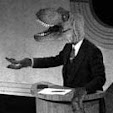So if you're from Milwaukee I'll ask you this: do you know about where in Milwaukee this house was from?

Here's a hint: its address was 519 Astor Street. Not helpful? It's from near the intersection of Biddle Street and Astor Street. Still not helpful? That's because all of Milwaukee's urban planners aspire to be Hunter S. Thompson. The house's description may prove useful in figuring out this problem.
 Milwaukee has gone through a series of street name changes, but the largest happened in 1930. Some streets were renamed, but most simply had a direction appended to them. Astor Street became North Astor Street. In addition, people couldn't pick whatever wacky address number they wanted (do you really want to live on 1 Bay Street next to 1 Aldrich Street?). Numbers were assigned according to a property's frontage (every 15' had a new number, every new block increased this number by 100). This house's address changed from 519 Astor Street to 913 North Astor Street.
Milwaukee has gone through a series of street name changes, but the largest happened in 1930. Some streets were renamed, but most simply had a direction appended to them. Astor Street became North Astor Street. In addition, people couldn't pick whatever wacky address number they wanted (do you really want to live on 1 Bay Street next to 1 Aldrich Street?). Numbers were assigned according to a property's frontage (every 15' had a new number, every new block increased this number by 100). This house's address changed from 519 Astor Street to 913 North Astor Street. Unfortunately, even having an address number and street name doesn't help us with this house. Keen visitors that click on my fancy links will already know the other problem. This house neighbored the intersection of Biddle and Astor. The problem being that Biddle Street became Kilbourn Avenue when Cedar and Biddle were widened and connected by a bridge over the Milwaukee river. The intersection of Astor and Biddle now encompasses the intersection of Kilbourn, Prospect and Astor.
View Larger Map
You know what will teach you streets pretty quick? Poring over fire liability maps of a city. Unfortunately, half those streets may not even exist anymore - like Biddle Street. The Sanborn Fire Insurance Map Company (talk about knowing your target market) created detailed, scale maps of thousands of American cities between 1867 and 1970. You can view black and white versions of these maps for Milwaukee online, but you may want the key.
Physically they're giant bound volumes about two feet square. With a scale of 1 inch to 50 feet, this means one page can show about 1000 feet on each side. Milwaukee is a rather large city, and the maps from 1910-1926 come in 6 volumes (about 20 giant bound books of maps). New volumes were ordered for expansions of the city limits, but the index map remains the same (which makes finding page numbers for modern streets not listed on the index that much more fun).
 Aside from being unwieldy in size, the individual pages are a bit strange. Directional north is not explicitly at the top of the page; each page has its own compass rose to denote which way is north. Unlike the online versions mentioned above, the actual maps are color-coordinated with the key. Each color indicates a specific building material (and therefore a building's status as a potential fire hazard). And finally, in order to provide up-to-date fire hazard information, the company provided new versions of buildings and streets that could be pasted into the volume on hand. This kept the maps current, but isn't so helpful when you're looking for an older demolished house, since it's bound to be under 3 layers of pasted revisions. In older versions of the map the presence of gas and electrical lines is often marked as well (if I had been around in 1910 I'd get an electrical line to my house just so some lazy surveyor has to pencil in "Electric Line" on some giant map).
Aside from being unwieldy in size, the individual pages are a bit strange. Directional north is not explicitly at the top of the page; each page has its own compass rose to denote which way is north. Unlike the online versions mentioned above, the actual maps are color-coordinated with the key. Each color indicates a specific building material (and therefore a building's status as a potential fire hazard). And finally, in order to provide up-to-date fire hazard information, the company provided new versions of buildings and streets that could be pasted into the volume on hand. This kept the maps current, but isn't so helpful when you're looking for an older demolished house, since it's bound to be under 3 layers of pasted revisions. In older versions of the map the presence of gas and electrical lines is often marked as well (if I had been around in 1910 I'd get an electrical line to my house just so some lazy surveyor has to pencil in "Electric Line" on some giant map). So where was that house from? It was located in downtown Milwaukee, where Kilbourn Avenue starts and the Regency House Condos now stand.
And maybe it's still there, like some sort of Morlock house.
